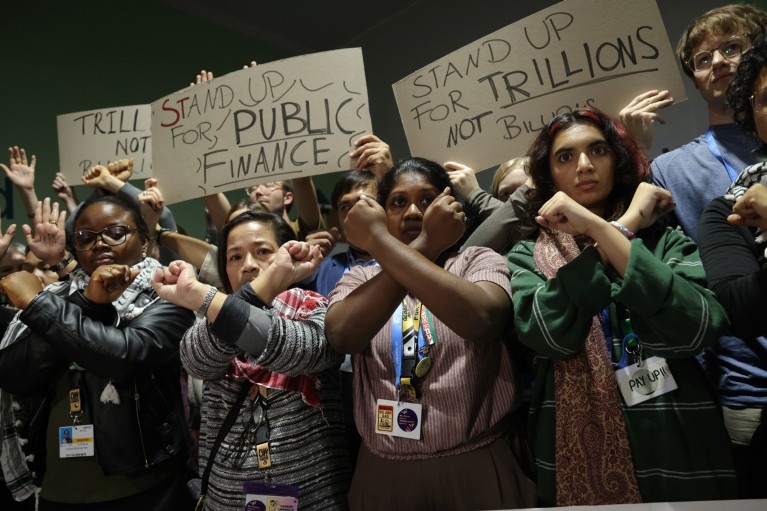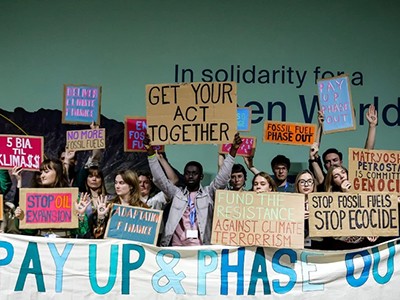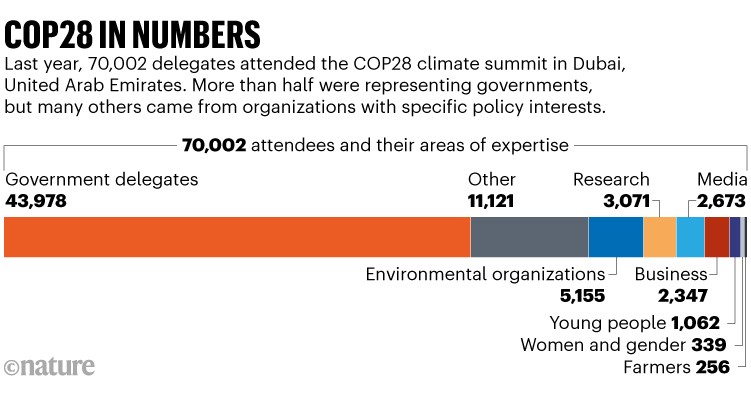
A climate finance protest at COP29 in Baku. Science activism is increasing.Credit: Sean Gallup/Getty
People in some 70 countries took part in various national elections this year, a record number. And in March, Nature reported that results in at least five polls could either boost or block climate action (see Nature 627, 22–25; 2024). Overall, it has been a dismal year, particularly for science in multilateral policymaking. The tension and mistrust between nations evident in the daily news is affecting the use of science in decision-making. Research is being ignored in international talks designed to meet global challenges, including those addressed by the United Nations Sustainable Development Goals (SDGs). Campaigners, scientists and policymakers are becoming ever more frustrated. Some are taking action through legislative means — this month, the International Court of Justice in The Hague, the Netherlands, has been hearing arguments about states’ obligations under international law to protect people from the effects of climate change. Others are opting for a more direct route, through science activism.
In the climate-change sector especially, there’s a view that the processes of the summits known as Conference of the Parties (COP) have had their day or, at the very least, need to be reformed. The research community needs to carefully and systematically study why scientific knowledge is being pushed out, as a first step to finding a way forward.
Twelve months of summitry
Let’s start with international climate negotiations. Even by COP standards, the COP29 climate-change conference in Baku last month ended with unusual acrimony between rich and poor nations about who is ultimately responsible for tackling the climate crisis. The funds eventually agreed — US$300 billion annually for developing clean-energy technologies and for nations to adapt to the effects of climate change — are inadequate to help the world avert dangerous levels of climate change, and to help some of the most vulnerable people deal with its effects.

Is the COP29 climate deal a historic breakthrough or letdown? Researchers react
The UN COP16 biodiversity meeting in Cali, Colombia, also ended without the funding boost needed to restore and protect nature. Countries pledged $163 million, which is orders of magnitude short of the $200 billion a year needed to reach the goal of protecting 30% of the world’s land and seas by 2030. Delegates did agree that large companies should pay if they made a profit using genetic information from nature, but payments will be voluntary.
The international community is also sharply divided on the scope of an agreement that is being negotiated to end plastics pollution. The latest talks in Busan, South Korea, have been extended into 2025. Talks on a pandemic treaty have also been pushed to next year. African nations are at odds with Europe and the United States over a request that low- and middle-income countries (LMICs) should have preferential access to pandemic-related products that are developed using their data.
And at the end of last week, delegates left the UN conference on dealing with droughts and desertification (UNCCD) in Riyadh without arranging to begin talks on a legally binding protocol to tackle the issue. However, they did agree to expand the UNCCD’s body of independent scientific advisers. September’s Summit of the Future in New York City, organized by UN secretary-general António Guterres also ended with some positive outcomes, including a bold statement that recognizes science as essential to tackling global challenges in its final document, the Pact for the Future. But questions need to be asked as to how this statement can be implemented in the current, highly polarized political climate.
Shrinking science
It might seem that the world is in a golden age of science in multilateral policymaking. Researchers at universities, in campaign groups and in industry are attending COPs and other meetings in considerable numbers: at least 3,000 scientists attended last year’s COP28 in Dubai, United Arab Emirates (see ‘COP28 in numbers’). They have a variety of roles. Some advise nations’ delegates, the policymakers involved in treaty negotiations. Others are members of official UN science advisory committees. And some come to the meetings to take advantage of the presence of the global media to publicize their research. And yet, despite scientists’ presence, it is evident to observers that COP delegates are not taking research into account in the actual talks. If they were, then negotiating positions would not be as polarized as they are becoming.

Source: UN Framework Convention on Climate Change
For instance, Nature argued last month that a study of climate finance by the Intergovernmental Panel on Climate Change (IPCC) would help to take some of the heat out of disagreements over money. Before the IPCC can commission such a study, a few countries have to propose it. However, until now, there have been no takers. This lack of interest seems like a break from the past, when research helped to shape legally binding agreements, such as the 1989 Montreal Protocol to prohibit the use of ozone-depleting substances, and the 1997 Kyoto Climate Protocol. And in 2015, research was at the core of the design of the SDGs.
Even though groups of scientists in several countries have proposed ways to end plastic pollution, they are struggling to make their voices heard at the talks on a plastics treaty. This is because the UN still hasn’t organized a formal system for researchers to advise during the discussions.
UN under pressure
It’s worth reflecting for a moment on why research is currently struggling to have an impact. When the present system of science advice in UN meetings was originally established, the United States and European countries were the world’s largest economies. Their delegates often dominated proceedings, or at least commanded an outsize presence during talks. Much of the research that underpinned UN environmental agreements also came from these nations, as did the scientists observing the talks and many of the world’s influential media outlets covering them.

How to stop plastic pollution: three strategies that actually work
But that world is changing. China is the second largest economy globally and India is on a path to becoming the third. An increasing amount of SDG-related research is now coming from LMICs. At the same time, the place of science in negotiations is affected by this shift in the balance of power. Put simply: when research is performed, or funded, by high-income countries, it is perceived by some in LMICs as being biased in favour of the negotiating positions of the governments of those nations.
Overall, the system that scientists use to access and influence UN environmental agreements is under strain. Meeting organizers, delegates and leaders of research institutions must find a way forward together. Science-based decision-making is what will ultimately help the world to resolve the crises it faces. It’s important to understand how and why research is being pushed to the margins and what needs to be done to get policy back on track.






